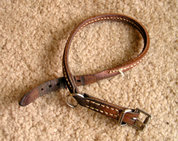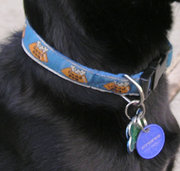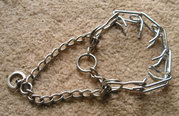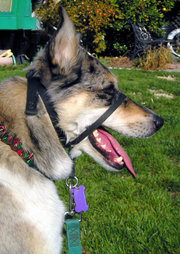Dogs
Dog Collar
|
From Wikipedia the free encyclopedia, by MultiMedia
|
Back | Home | Up | Next |
A Dog collar is a
collar worn by
Dogs; usually
with a
Dog tag with the owner's telephone number or the Dog's
vaccination information on it.
Dog collar is also an informal term for a
clerical collar and for a
necklace
similar to a wide
choker, popular in the
Edwardian period; see
Collar (jewelry).
Basic collars
 Leather buckle collar with traditional buckle.
Leather buckle collar with traditional buckle.
A collar is a piece of material put around the neck of a Dog for control,
identification, or other purposes. Identification tags and medical information
is often placed on collars. Collars are also useful for controlling the Dog, as
they provide a handle for grabbing.
- Buckle collars, also called flat collars, are usually
nylon or leather with a buckle similar to a belt buckle or a quick-release
buckle, either of which holds the collar loosely around the Dog's neck.
Usually identification is attached to such a collar; it also comes with a
loop to which a leash can be fastened.
 Nylon quick-release buckle collar with identification and medical tags.
Nylon quick-release buckle collar with identification and medical tags.
-
Flea collars are impregnated with chemicals that repel
fleas. They are
usually a supplementary collar, worn in addition to the conventional buckle
collar.
- An
Elizabethan collar, shaped like a truncated cone, is worn by a pet,
usually a cat or Dog, to prevent it scratching a wound on its head or neck
or licking a wound or infection on its body.
Training collars
Several types of collars are used for
Dog
training:
- Flat collars: Many Dogs are trained on leash using a buckle or
quick-release collar.
 Slip collar, showing how the chain pulls through the loop at one end.
Slip collar, showing how the chain pulls through the loop at one end.
-
Slip chain (also called
choke chain, slip collar, or choke collar) is a length of chain or
nylon rope with rings
at either end such that the collar can be formed into a loop around the
animal's neck that slips (adjusts) tighter when pulled and slips looser when
tension is released. Used for training if the Dog is not responsive on a
buckle collar; provides some additional control and prevents a wild Dog from
being able to thrash its way out of a looser collar. It can also, when
pulled hard enough, tighten around the neck in a way that prevents airflow.
Properly used, the slip collar is quickly popped and released as a firm
reminder to the Dog to pay attention; it is not pulled tight and held.
 Prong collar; the looped chain limits how tightly the collar can pull in the
same way that a Martingale functions.
Prong collar; the looped chain limits how tightly the collar can pull in the
same way that a Martingale functions.
- Prong collar (also called pinch collar) is a series of chain links with
open ends turned towards the Dog's neck so that, when the collar is
tightened, it pinches the naturally loose skin around the Dog's neck. When
properly adjusted and used, it startles the Dog and gives a sharp
correction, but it is very difficult if not impossible to actually puncture
the skin. Proponents argue that this is how mother Dogs or adult Dogs of
higher rank correct misbehaving puppies or lower-rank Dogs, by grabbing the
loose skin around the neck in their teeth. Opponents argue that pain is
never a good default way in which to train animals. Some Dogs are nearly
oblivious to leash corrections of any kind, including the prong collar, but
the prong collar might make such Dogs pay more attention than other collar
types. The advantage of the prong collar over the choke collar is that the
circumference is limited so that it is impossible to compress the animal's
throat.
-
Martingale collars have a longer section usually made of leather, chain,
or nylon, joined through loops by a circle of chain or leather to which the
leash is fastened; pulling on the leash tightens the collar, but the wide
section both prevents the chain from tangling in a Dog's coat and prevents
the collar from being pulled tightly enough to cut off the Dog's airway.
-
Stud collar is fitted with sharp points and metal studs that prevent
another animal from biting the neck. While such a collar may appear brutal,
it is actually the best collar for a milder mannered or older animal
interacting with its more aggressive fellows.
 The halter-style collar controls the Dog's head but does not restrict its
ability to pant, drink, or grasp objects.
The halter-style collar controls the Dog's head but does not restrict its
ability to pant, drink, or grasp objects.
- Halter
collar, such as those sold under the brand names Haltie or Gentle Leader;
like a halter on a horse, this collar fastens around the back of the neck
and over the top of the muzzle, giving more control over a Dog's direction
and the intensity of pulling on a leash than collars that fit strictly
around the neck. Pressure on this type of collar pulls the Dog's head
towards the handler.
Home | Up | Animal Muzzle | Clicker | Crate Training | Dog Collar | Doghouse | Elizabethan Collar | Halter | Dog Harness | Leash | Dog Tag | Martingale (Fastener) | Microchip Implant | Rug | Dog Sled | Sulky | Dog Whistle
Dogs, made by MultiMedia | Free content and software
This guide is licensed under the GNU
Free Documentation License. It uses material from the Wikipedia.
collie breed working terrier hound spaniel baiting bullDog
 Leather buckle collar with traditional buckle.
Leather buckle collar with traditional buckle. Leather buckle collar with traditional buckle.
Leather buckle collar with traditional buckle. Nylon quick-release buckle collar with identification and medical tags.
Nylon quick-release buckle collar with identification and medical tags. Slip collar, showing how the chain pulls through the loop at one end.
Slip collar, showing how the chain pulls through the loop at one end. Prong collar; the looped chain limits how tightly the collar can pull in the
same way that a Martingale functions.
Prong collar; the looped chain limits how tightly the collar can pull in the
same way that a Martingale functions. The halter-style collar controls the Dog's head but does not restrict its
ability to pant, drink, or grasp objects.
The halter-style collar controls the Dog's head but does not restrict its
ability to pant, drink, or grasp objects.